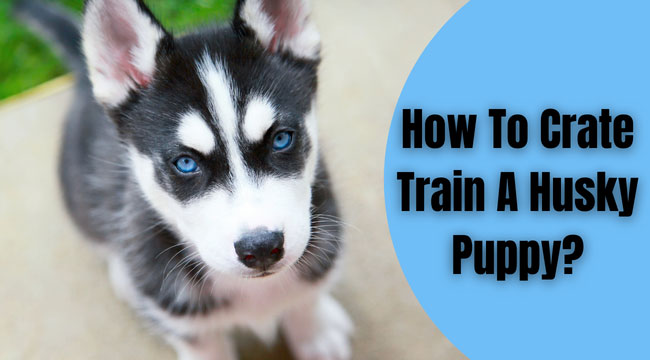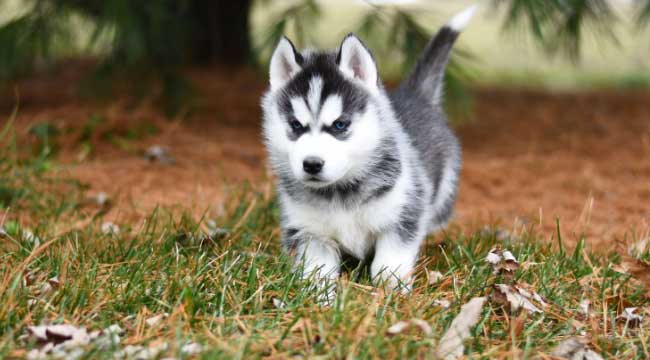
When you bring home your new Husky, one of the first things you’ll need to do is train him to go into his crate. This is an essential part of housetraining and will help keep your dog safe when you’re not able to watch him.

Your Husky is a very vocal pet, and when it comes time to crate train him or get into his kennel for the night, they will let you know exactly how he feels about things right away with screams of joy from outside the door.
Read More:
- how to take care of husky
- How Soon Should You Start Training With Your New Pup?
- Dog Care Basics: Your Fur-Ever Friend Needs These 6 Things To Be Healthy
- How to Properly Choose Dog Food According to the Breed?
- An Expert Guide to Buying Your First Dog Crate
Has anyone ever told you that owning a husky is a lot of work? Well, they’re not wrong! But it’s worth it, especially when they’re as adorable as husky puppies. If you’re new to husky ownership or just looking for tips on how to crate train your pup, look no further! This post will cover the basics of Crate training and how to make the process smooth (and stress-free) for you and your pup. Happy training!
Related Post: Bernese Mountain Dog Husky Mix
Crate training your Husky
If you don’t know how to crate train your Husky, now is the time to start. A crate will be a safe place for your dog when you’re not home, when he’s tired or at night. Crate training your Husky can help keep your home from getting damaged if he misses you while you’re away. Over time, as your Husky gets used to his crate, he will see it as his personal safe place. This will be where he goes when he needs a nap during the day or when you’re not home.
Before starting
When you crate train your Husky, you will teach him where he can and cannot go and where he will be during certain times during the day. For example, you will teach him what to do when you are not home. Crate training can start at any age, but it is easiest when your Husky is young. This way, he will think of the crate as his personal space.
You can choose to crate train your Husky only during the day, allowing him free reign of the house at night while you sleep. Or you can train your Husky to sleep in the crate only or both. Eventually, you will notice your Husky going into the crate on his own when he feels like taking a break from everything or when it is bedtime.
Getting Started
Crate training is easy when you are ready. You will need a crate that is big enough for your Husky to stand up and turn around in. There is no need to get a different crate for a puppy and an adult. But you may want to block off some of the space in the crate when your Husky is a puppy, so your pup doesn’t use the extra room as a potty.
The key to making your Husky love his crate is to make it a comfortable and fun place. Be sure to provide plenty of soft bedding and new toys to keep him entertained. You can also give him some high-value treats to encourage him to go into the crate and remind him he’s safe while he’s training. Here is a list of good dog dens for your Husky.
how to crate train a husky puppy

Step one: Place the crate
The placement of your Husky’s crate is important for crate training to be successful. Place the crate in a spot where your Husky will feel comfortable sleeping at night. This may be in or near your bedroom, a quieter part of the house, or even a popular family room area. Make sure you hear your Husky if he is still potty training and is a puppy.
Step Two: Play and potty
Make sure you take your dog outside for one last potty trip before bed. While he’s out, play with him and make it as easy on the pup by wearing them down, so they’re tired enough that nighttime training goes better in their crate!
Step Three: Good night
“It’s time for bed!” You say to your pup in an upbeat voice while giving him strokes on the back. “You’re such a good boy! Good night sweetie pie.” The command phrase ‘goodnight’ will now be linked with going into his crate, so he knows what needs to be done during nap or nighttime sleep.
Step Four: Giving Him A Treat
Give your pup a tasty treat and place one inside his crate, encouraging him to get it. Set up the room with bedding so he can sleep all night comfortably!
Step Five: Close the crate door
Once your husky is comfortable going in and out of the crate, you can begin closing the door while he is inside. Start by closing the door for just a few seconds and gradually increase the amount of time you leave him inside. You may need to hang out for a few moments encouraging him with a soft voice to stay and go to sleep. But if you are consistent with the crate training, your husky will soon learn that staying in his crate is good.
Step Six: Whining and crying
If your Husky screams after being placed in the crate, tell him to ‘go night-night’ or ‘good night’ in a soft voice. Before bed, you can give him one more reward, but then walk away and let him whine until he falls asleep. You might want to stick close by so he knows you’re there and doesn’t have the impression that he’s been abandoned.
Step Seven: Husky puppy
It’s important to remember that your husky puppy can only hold his bladder for about an hour for every month of his age. So, if your pup is just four months old, he can only hold it for four hours. If your Husky is four months old, he may wake three to four times during the night to go potty. He should whine and let you know he needs to go. When you let him out of his crate, carry him outside rather than letting him walk, so he doesn’t stop to go potty in the house. Outside of using the potty, let any other whining go with a simple treat and a wish for a good night sleep.
Step Eight: Patience
Don’t use the crate too much. Use it only when you know you can’t watch your Husky, for short moments when you’re home but worried, like when you’re taking a shower and at night time. Be patient with your Husky as he gets used to using the crate for short periods of time when he’s alone or sleepy.
Conclusion
Owning a Husky is definitely a lot of work, but it’s so worth it when you have an adorable pup that loves to give you kisses. Please share this post with your friends who are thinking about getting a Husky and let us know in the comments below how your own training is going. We would love to hear from you!
Resources:
https://wagwalking.com/training/crate-train-a-husky-puppy



